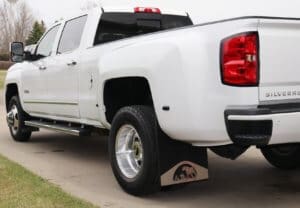Do You Need a Dually?
If you’re in the market for a new truck, there are many options to consider, from horsepower strength to full-size cabs and hitch strength. Another critical factor is whether or not you need a dually.
 A dually truck, or DRW for short, has six wheels–two in the front and then two sets of two in the rear. It’s easy to spot a dually because of the more pronounced fenders required to cover both sets of tires. On average, a dually is about one foot wider than a standard truck.
A dually truck, or DRW for short, has six wheels–two in the front and then two sets of two in the rear. It’s easy to spot a dually because of the more pronounced fenders required to cover both sets of tires. On average, a dually is about one foot wider than a standard truck.
These pickups look like workhorses and for good reason. Dually trucks offer higher towing and payload capacity and can handle heavy-duty jobs, but those extra wheels do much more than just that.
Dually trucks provide greater traction to the road. Because there is more contact with the ground, a dually has more stability driving in wet or muddy conditions.
Another significant benefit of a dually truck is the way it limits sway that can happen when pulling a trailer. Sway happens when movement and wind combine to push the trailer left and right while traveling on the road. The height of the trailer acts like a kite on the highway. In worst-case scenarios, sway can flip a trailer and its accompanying truck over.
To understand how a dually helps, you need to know the average dimensions of pickup trucks and travel trailers. Most travel trailers are eight feet wide. Pickup trucks are somewhere around six and ¾ feet wide. Rounding up to seven, this means when a regular pickup truck is pulling a travel trailer, there’s about a foot of difference between the alignment of the truck’s tires and that of the trailer.
Second, sway happens at the connection point between the back of the truck and the front of the travel trailer. The hitch holding the two together acts as a hinge. When wind hits the side of the trailer and puts more pressure on one side than the other will make the trailer begin to sway. With a regular pickup truck, the difference in alignment between the truck and the trailer tires makes it more difficult to manage and control when this happens. Special hitches are often used to reduce sway but only provide limited effectiveness with a regular truck and bumper hitch.
Dually trucks solve these problems.
First of all, the extra width of the dually better aligns the truck’s tires to that of the trailer. This will make it more manageable to navigate the trailer, especially when a special sway-reduction hitch is installed. These special hitches are much heavier than regular hitches, so the extra towing capacity helps perform the job better than a standard truck.
Second, a dually is well-equipped to pull a fifth wheel, which is an even better solution for reducing sway. Because the fifth wheel uses a bed-mounted hitch, the trailer, and the truck bed overlap. In other words, the overlap creates almost a solid “wall” between the truck and the trailer. Those dual tires are on each side of the hitch and control any movement happening at that point. This reduces the openness between both elements and nearly eliminates sway entirely.
Regardless of the type of truck you decide to purchase, DuraFlap has the highest quality Dually Mudflaps to fit your rig.
DuraFlap’s patented drill-less dually mudflaps use holes already existing in your vehicle’s body. Our dually mudflaps are easy to install (they can be installed without taking the tires off) and present no new holes that are prone to rust and corrosion.
Your new DuraFlap mudflaps will give you years of protection. Our exclusive “rain grooves” direct rain, snow, and road debris down and away from the vehicle. The flaps are constructed from ⅜” polyethylene/rubber blend material and feature anti-sail and anti-spray capabilities.
Give your truck a custom look by adding artwork to your mudflaps. Our online art catalog features over 100 designs, or we can create custom artwork based on your ideas or sketch. Your truck will represent your unique personality!